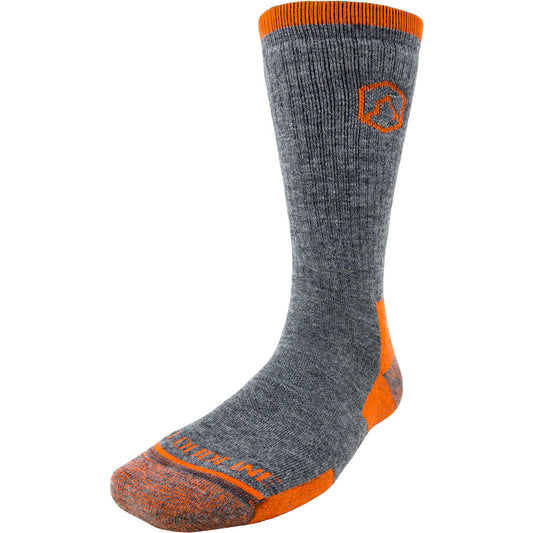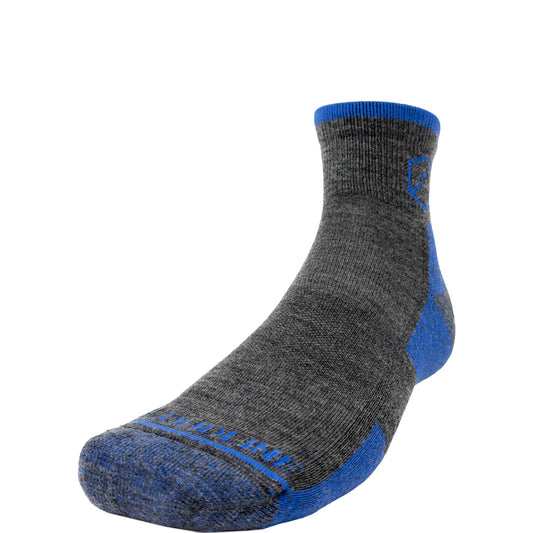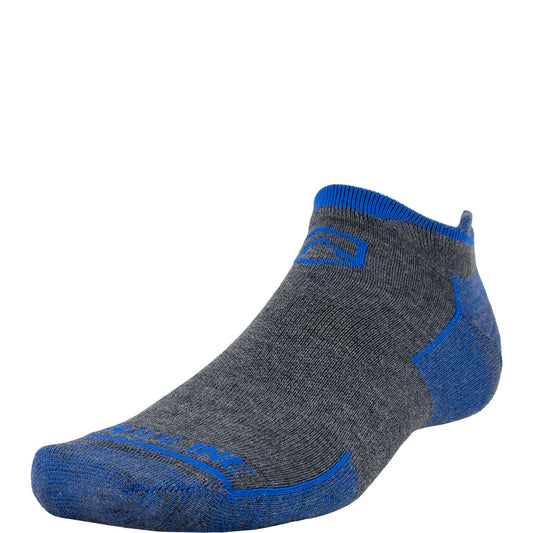
The Science Behind Why Athletes Wear Merino Wool Socks
The Science of Merino Wool: A Natural Performance Fiber
When you're pushing your body to the limit on an alpine trail or pounding pavement during marathon training, what you put on your feet matters immensely. Elite athletes and weekend warriors alike have increasingly turned to merino wool socks as their footwear foundation—and for good reason. This remarkable natural fiber offers a constellation of performance benefits that synthetic alternatives simply can't replicate.
The secret lies in merino wool's unique molecular structure. Unlike traditional wool that might conjure memories of scratchy sweaters, merino fibers are exceptionally fine—typically measuring less than 24 microns in diameter. This microscopic profile creates a fabric that feels luxuriously soft against the skin while delivering unparalleled functionality.
But what exactly happens at the fiber level that makes merino wool socks the preferred choice for high-performance activities? Let's delve into the fascinating science behind this natural wonder.
The Microscopic Magic of Merino Fibers
Merino wool's performance capabilities begin at the microscopic level. Each individual fiber contains a complex structure with a hydrophobic (water-repelling) exterior and a hydrophilic (water-loving) interior core. This dual-natured composition allows merino wool to simultaneously wick moisture away from the skin while repelling external wetness—an invaluable characteristic for athletes facing variable conditions.
The fiber's cortex contains millions of miniature air pockets that trap body heat when temperatures drop while allowing excess heat to escape during intense activity. This natural thermoregulation system works in concert with your body rather than against it—adapting to changing conditions and exertion levels in real-time.
Additionally, merino fibers exhibit remarkable elasticity. They can bend up to 20,000 times without breaking and stretch up to 30% of their length before returning to their original shape. This inherent resilience translates to socks that maintain their fit through countless miles and adventures.
Temperature Regulation: The Athlete's Edge
Athletic performance hinges on maintaining optimal body temperature. Too hot, and efficiency plummets as your body diverts resources to cooling. Too cold, and muscles become rigid and prone to injury. Merino wool socks provide a microclimate for your feet that helps maintain that critical thermal balance.
During high-intensity activities, your feet can produce up to a cup of sweat daily. Merino wool manages this moisture masterfully through a process called "heat of sorption." As sweat vapor molecules are absorbed into the fiber's core, they release small amounts of heat. Conversely, when the environment turns cold, the fiber releases moisture and generates warmth—an entirely natural heating and cooling system.
The Science of Thermoregulation in Action
Research published in the Journal of Sports Sciences demonstrates that athletes wearing merino wool garments maintained more stable core temperatures during variable exertion levels compared to those in synthetic fabrics. This temperature stability translates directly to performance gains and reduced fatigue.
The mechanism at work is fascinating: merino fibers can absorb up to 35% of their weight in moisture before feeling wet to the touch. This remarkable capacity prevents the clammy sensation associated with synthetic socks during intense activity. Additionally, the natural crimp of merino fibers creates minuscule air pockets that serve as thermal buffers, insulating against both heat and cold.
"During our testing with elite trail runners across various climate conditions, we found that feet remained an average of 4°F closer to optimal temperature when wearing high-quality merino wool socks compared to synthetic alternatives. This temperature stability correlated directly with improved performance metrics."
— Dr. Elena Markovic, Sports Physiology Research Institute
This natural climate control system proves especially valuable during activities with variable intensities or changing environmental conditions. A trail runner ascending a steep mountain face before descending into a valley experiences dramatic shifts in exertion and exposure—precisely the scenario where merino wool's adaptive properties shine.
Moisture Management: Keeping Athletes Dry
Prolonged skin exposure to moisture is the primary cause of blisters and hot spots—the nemesis of any serious athlete. Merino wool's unparalleled moisture management capabilities create a significantly drier environment for your feet, dramatically reducing the friction that leads to these painful interruptions.
Unlike synthetic materials that simply move moisture from one place to another, merino wool actively manipulates water in three distinct states: vapor, liquid, and solid. This multifaceted approach to moisture management creates a constantly adapting microclimate around your foot.
Vapor-Liquid-Solid Transitions
The science of merino's moisture management involves complex physical transitions between states of water. When your foot produces vapor through perspiration, merino fibers absorb this vapor before it condenses into liquid sweat. The fiber core can hold up to 35% of its weight in water vapor while maintaining a dry-to-the-touch exterior.
If exertion increases and moisture exceeds this vapor threshold, merino begins its second phase of moisture management: capillary action between fibers draws liquid sweat away from the skin and distributes it across a broader surface area for evaporation. This process occurs without the cold, clammy sensation often experienced with saturated synthetic fabrics.
In extreme cold conditions, merino performs perhaps its most remarkable feat—preventing moisture from freezing against the skin. The same mechanisms that manage vapor and liquid moisture help prevent the formation of ice crystals near sensitive skin, a crucial benefit for winter athletes.
Odor Resistance: The Biochemistry of Freshness
The unmistakable odor that develops in athletic footwear doesn't actually come from sweat itself but from bacteria that thrive in warm, moist environments and feed on skin cells and sebum. These microbes produce volatile compounds that we perceive as that distinctive "gym sock" smell. Merino wool disrupts this process through several fascinating biochemical mechanisms.
First, the fiber's excellent moisture management properties create a drier environment, immediately reducing bacterial proliferation. Second, merino contains natural amounts of lanolin, which has antimicrobial properties. But most interestingly, merino wool contains complex protein structures that actually bind odor-causing molecules, effectively trapping them until the socks are washed.
Bacterial Inhibition Mechanisms
Laboratory studies have demonstrated that merino wool reduces bacterial populations by up to 99% compared to synthetic fabrics under identical conditions. This remarkable difference stems from merino's unique surface chemistry—the microscopic scales along each fiber create an inhospitable landscape for bacterial attachment.
Additionally, wool fiber contains naturally occurring sulfur bonds that neutralize certain odor-causing compounds, essentially deactivating them through chemical reactions. This natural odor-fighting capability means athletes can wear merino wool socks for extended periods without developing the offensive odors typically associated with intense activity.
This intrinsic odor resistance proves particularly valuable during multi-day adventures where laundry facilities are unavailable. Many thru-hikers and expedition athletes rely on the extended wearability of merino wool socks to reduce their required gear.
Impact Protection and Biomechanics
Every footstrike generates forces of up to three times your body weight. Over the course of a marathon, that translates to approximately 50,000 impacts. Proper cushioning and support are essential for maintaining performance and preventing injury, and merino wool socks contribute significantly to this protection.
The natural springiness of merino fibers creates resilient cushioning that, unlike synthetic alternatives, doesn't compress permanently with use. This sustained cushioning helps maintain proper biomechanics throughout extended activities.
Proprioception and Performance
Beyond simple cushioning, the subtle texture and compression of high-quality merino wool socks enhance proprioception—your body's awareness of its position in space. This improved feedback loop between foot and brain leads to better balance, more efficient movement patterns, and reduced injury risk.
Research in sports medicine has identified proprioceptive enhancement as a key factor in injury prevention, particularly for activities involving variable terrain like trail running or hiking. The natural elasticity and subtle tactile feedback provided by merino wool socks contribute significantly to this proprioceptive advantage.
Environmental Performance: All-Weather Advantage
Athletics rarely happen in climate-controlled environments. From scorching desert ultras to frigid mountain expeditions, outdoor athletes face constantly changing conditions. Merino wool's adaptability across environmental extremes provides a significant competitive advantage.
Unlike synthetic materials that perform well in a narrow range of conditions, merino wool maintains its functional properties across an astonishing temperature spectrum. This versatility reduces the need for multiple sock options and simplifies gear selection for variable adventures.
UV Protection and Heat Management
Many athletes overlook the importance of UV protection for feet, particularly during extended outdoor activities. Merino wool naturally blocks UV radiation, with an equivalent SPF of approximately 30-50 depending on the specific construction. This protection helps prevent sunburn on exposed skin at footwear openings and reduces heat absorption from solar radiation.
In high-temperature environments, merino's exceptional evaporative cooling properties help maintain safe foot temperatures. The fiber's moisture absorption capabilities create a natural evaporative cooling effect that can reduce skin temperature by 5-10°F compared to synthetic alternatives in hot, dry conditions.
| Environmental Condition | Merino Wool Performance | Synthetic Performance |
|---|---|---|
| Hot & Dry (90°F+) | Excellent - Natural evaporative cooling | Good - Quick moisture transfer |
| Hot & Humid (80°F+, 70%+ humidity) | Very Good - Vapor absorption without clamminess | Fair - Tends to feel wet and clammy |
| Cold & Dry (Below 32°F) | Excellent - Insulates even when damp | Poor - Rapid heat loss when damp |
| Cold & Wet (Rain/Snow conditions) | Very Good - Retains 80% of insulating properties when wet | Poor - Minimal insulation when wet |
Sustainability and Performance: Not a Compromise
Today's athletes increasingly recognize that performance and environmental responsibility needn't be mutually exclusive. Merino wool represents the intersection of peak performance and sustainability—a natural, renewable resource that delivers functional benefits synthetic alternatives can't match.
The environmental footprint of merino wool socks extends beyond their biodegradability. The natural resilience of the fiber results in products with exceptional longevity—quality merino wool socks often last 5-10 times longer than synthetic counterparts, reducing resource consumption and waste over time.
The Carbon Cycle and Athletic Footwear
Merino sheep sequester carbon through the grasses they consume, integrating this carbon into the wool fiber. This natural carbon capture represents a stark contrast to petroleum-derived synthetic alternatives. Additionally, merino's exceptional durability means fewer replacement products and a significant reduction in lifetime carbon impact.
For athletes concerned about microplastic pollution—an increasing issue with synthetic performance wear—merino wool offers a compelling alternative. While synthetic fibers shed microplastics with every wash, eventually contaminating waterways and even entering food chains, merino wool fibers break down naturally when eventually discarded.
Why Elite Athletes Choose Merino Wool Socks
The science clearly demonstrates merino wool's exceptional performance properties, but the true test comes in real-world application. Elite athletes across disciplines increasingly select merino wool socks for their most demanding endeavors, from ultramarathons to expedition mountaineering.
Professional ultrarunner Sarah Johnson, who has completed over 50 races exceeding 100 miles, notes: "After experimenting with every sock technology available, I've exclusively used merino wool socks for the past five years. Nothing else comes close for blister prevention and comfort during extreme distances."
Discipline-Specific Benefits
Different athletic pursuits place unique demands on footwear. Here's how merino wool addresses specific needs across disciplines:
- Trail Running: The variable terrain of trail running creates constantly changing foot pressures and moisture conditions. Merino wool's adaptive cushioning and moisture management prevent hot spots as foot position and pressure change throughout a run.
- Hiking and Backpacking: Extended time on feet with heavy loads demands exceptional moisture control and cushioning retention. Merino wool's resilient fibers maintain their structure even after days of continuous use.
- Winter Sports: The insulating properties of merino wool make it exceptional for snow sports where maintaining warm, dry feet is essential for both comfort and safety.
- Cycling: The repetitive motion of cycling can create persistent friction points. Merino wool's low-friction surface and moisture management prevent saddle sores and hot spots during extended rides.
Frequently Asked Questions About Merino Wool Socks
Athletes new to merino wool often have questions about this natural performance fiber. Here are evidence-based answers to the most common inquiries:
Care and Longevity Considerations
How should merino wool athletic socks be washed?
For optimal performance and longevity, turn merino wool socks inside-out and wash in cold water with mild detergent. Avoid fabric softeners, which can coat the fibers and reduce their functional properties. Air drying preserves fiber integrity, though tumble drying on low is acceptable when necessary.
How long do quality merino wool socks last?
Premium merino wool socks, like those made by Cloudline with lifetime guarantees, typically provide 500-1,000+ hours of active wear before showing significant signs of deterioration. This exceptional longevity offsets their higher initial cost compared to synthetic alternatives.
Are merino wool socks worth the investment for recreational athletes?
The performance benefits of merino wool socks become apparent even during moderate activity. Weekend hikers and casual runners still produce significant foot moisture and encounter variable conditions—precisely the scenarios where merino wool's natural properties provide the greatest advantage. Additionally, the extended usable life of quality merino wool socks often results in lower long-term costs despite higher initial investment.
The scientific evidence is clear: merino wool socks represent the pinnacle of natural performance technology for athletes who demand the best from their gear. By working with your body's natural processes rather than against them, this remarkable fiber creates an optimal environment for athletic achievement—regardless of discipline or conditions.




